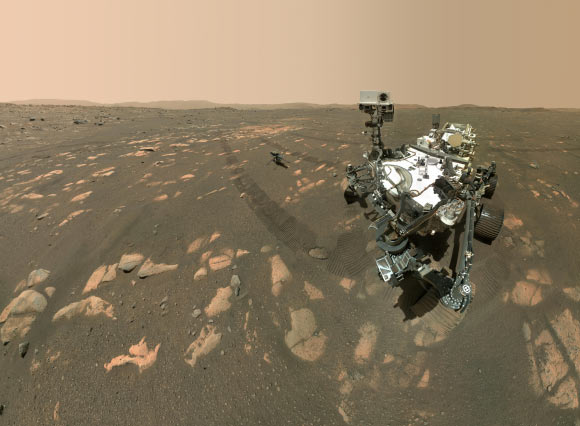On April 20, 2021, the Mars Oxygen In-Situ Resource Utilization Experiment (MOXIE) instrument aboard NASA’s Perseverance rover converted some of carbon dioxide-rich Martian air into oxygen. While the technology demonstration is just getting started, it could pave the way for science fiction to become science fact — isolating and storing oxygen on Mars to help power rockets that could lift astronauts off the planet’s surface.

This image was taken by the WATSON camera on the robotic arm of Perseverance on April 6, 2021 (46th Martian day, or sol, of the mission). Image credit: NASA / JPL-Caltech / MSSS.
Carbon dioxide makes up about 96% of the gas in the atmosphere of Mars. Oxygen is only 0.13%, compared to 21% in Earth’s atmosphere.
MOXIE works by separating oxygen atoms from carbon dioxide molecules. A waste product, carbon monoxide, is emitted into the Martian atmosphere.
The conversion process requires high levels of heat to reach a temperature of approximately 800 degrees Celsius (1,470 degrees Fahrenheit).
To accommodate this, the MOXIE unit is made with heat-tolerant materials: 3D-printed nickel alloy parts, which heat and cool the gases flowing through it, and a lightweight aerogel that helps hold in the heat.
A thin gold coating on the outside of the instrument reflects infrared heat, keeping it from radiating outward and potentially damaging other parts of Perseverance.
In this first operation, MOXIE’s oxygen production was quite modest — about 5 grams, equivalent to about 10 min worth of breathable oxygen for an astronaut.
MOXIE, which is designed to generate up to 10 grams of oxygen per hour, is expected to extract oxygen at least nine more times over the course of a Martian year (nearly two years on Earth).
“This is a critical first step at converting carbon dioxide to oxygen on Mars,” said Dr. Jim Reuter, associate administrator for NASA’s Space Technology Mission Directorate.
“MOXIE has more work to do, but the results from this technology demonstration are full of promise as we move toward our goal of one day seeing humans on Mars.”
“Oxygen isn’t just the stuff we breathe. Rocket propellant depends on oxygen, and future explorers will depend on producing propellant on Mars to make the trip home.”
“For rockets or astronauts, oxygen is key,” added MOXIE’s principal investigator Dr. Michael Hecht, a researcher at MIT’s Haystack Observatory.
“MOXIE isn’t just the first instrument to produce oxygen on another world,” said Dr. Trudy Kortes, director of technology demonstrations within NASA’s Space Technology Mission Directorate.
“It’s the first technology of its kind that will help future missions live off the land, using elements of another world’s environment, also known as in-situ resource utilization.”
_____
This article is based on text provided by the National Aeronautics and Space Administration.







